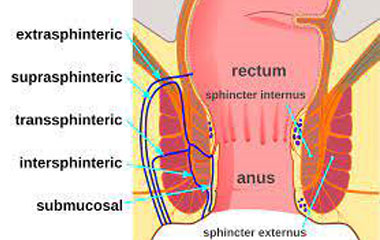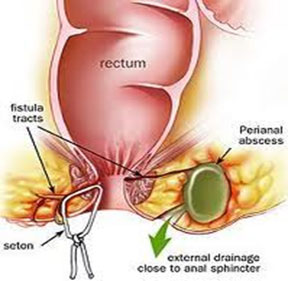FISTULA – IN - ANO
What is a fistula?
A fistula is an abnormal passage between two internal organs or from an internal organ to the body surface.
Fistula-in-ano is a hollow tract lined with granulation tissue, connecting an opening inside the anal canal to another opening in the perianal skin.
Fistula can be of two types
- Low Fistula
- High Fistula (Complex Fistula)
Why do fistula develop?
- Fistula-in-ano is nearly always caused by a previous anorectal abscess (localized collection of pus in the anorectal region)
- Secondary to trauma
- Crohn disease
- anal fissures
- Carcinoma
- Radiation therapy
- Infections like Actinomycoses, tuberculosis and chlamydia infection.
Signs and symptoms of fistula-in-ano :
- Pain in the anal region.
- Swelling near the anus.
- Bleeding while passing stools.
- Diarrhea.
- Skin excoriation around the anus.
- External opening apart from the anal opening.
- Abdominal pain
- Weight loss
- Change in bowel habits
Investigations
Radiologic studies are not performed for routine fistula evaluation. However, they can be helpful when the primary opening is difficult to identify. In the case of recurrent or multiple fistulas, such studies can be used to identify secondary tracts or missed primary openings
Fistulography
This involves injection of contrast via the external opening, which is followed by x-ray images to outline the course of the fistula tract
Endoanal/endorectal ultrasonography
These studies are reported to be 50% better than physical examination alone to help find an internal opening that is difficult to localize.
MRI
MRI is becoming the study of choice when evaluating complex fistulas and recurrent fistulas.
CT scan
A computed tomography (CT) scan is more helpful in the setting of perirectal inflammatory diseases.
Treatment Indications
Treatments for fistulas vary depending on their location and severity of symptoms.
Low Anal Fistula
- Drainage of perianal abscess followed by fistulectomy at later date if required
- Fistulotomy: A probe is passed into the tract through the external and internal openings. The overlying skin, subcutaneous tissue, and internal sphincter muscle are divided with a knife or electrocautery, thereby opening the entire fibrous tract.
- Fistulectomy is coring out of entire fistula track
- Laser ablation of fistula track and closing the internal opening
High Anal Fistula
- Seton tightening with staged procedure
- Laser ablation of fistula track with closing of internal opening
Preoperative Procedures
- Most patients who undergo a fistulotomy can go home from the hospital the same day. If a patient must remain in the hospital, he or she is usually discharged the following day.
- As with any surgical procedure, certain preoperative tests are ordered. Blood and urine tests, a chest x-ray, and an ECG may be required. The need for additional tests depends on the patient's health and if general anesthesia is going to be utilized. These tests are normally done a few days prior to the surgery.
- Medications that "thin" the blood, including aspirin, are usually discontinued several days before scheduled surgery. On the day of surgery, other prescription drugs may also be held. The need for discontinuing medications must be discussed with the physician before the operation.
- If general anesthesia is going to be used, nothing can be eaten from midnight on the evening before surgery until after the procedure. This includes all food, water, chewing gum, and candy. This precaution decreases the possibility of vomiting during and after surgery.
- Check-in is usually the same day as the surgery.
Post - operative care:
Home Care
- Avoid strenuous activity for 1-2 days after your procedure.
- Take sitz baths (sit for 10 minutes in about 3 inches of warm water) at least 3 times a day and after each bowel movement.
- Don’t worry if you have some bleeding, discharge, or itching during your recovery. This is normal.
- Avoid constipation.
- Use a laxative or stool softeners-
- Eat more high-fiber foods.
- Drink 6-8 glasses of water a day, unless directed otherwise.
- Spend less time sitting on the toilet.
- Avoid straining with bowel movements. Straining increases pressure and irritation, which can lead to pain and swelling.
When to Call Your Doctor
Call your doctor right away if you have any of the following:
- Fever above 100.5°F
- A large amount of drainage or bleeding
- Trouble urinating
- No bowel movement for more than 48 hours
Follow-Up
Make a follow-up appointment for 2 weeks after your surgery

